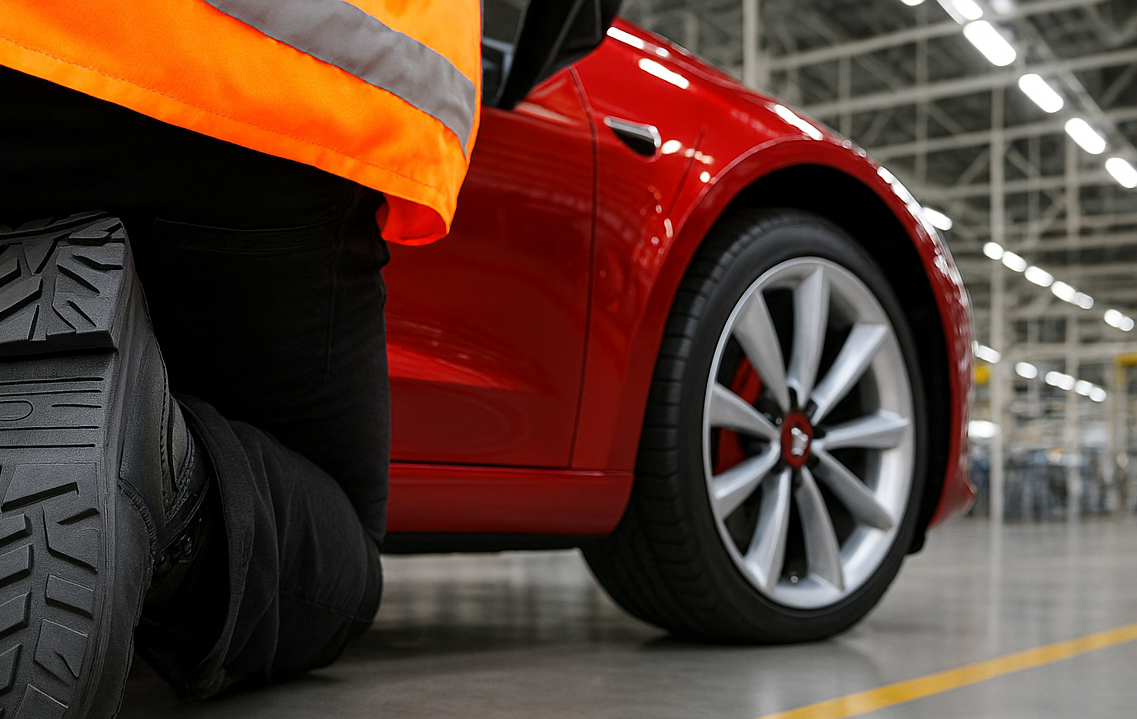The EN ISO 20345 safety footwear standards underwent some significant updates in 2022, and has existed alongside the older 2011 edition for some time. However, the older standard is being withdrawn and officially replaced by the 2022 version on 11th November 2024.
Therefore, if you’re in charge of Health and Safety or procurement, it’s important to firstly understand these changes to ensure compliance and maximise your team's workplace safety. But knowing the safety standards can also be a very effective framework to help you ensure that, based on the hazards and workplace conditions of your team, your wearers are using the correct spec to optimise safety, comfort and well-being - particularly as new footwear will be more commonly tested to this newer standard in the coming months and years.
Knowing the changes in standards will also be important for specifying and requesting safety footwear from your suppliers, because being able to be specific on the right level of protection can make the process a lot swifter.
2011 AND 2022 STANDARDS – KEY DIFFERENCES
The 2022 safety footwear standard updates affect a number of areas including changes to:
- Slip-resistance
- Water-resistance
- Codes and tests in nail penetration
- Ladder grip tests
As well as other aspects including testing methods and markings, but in this blog, you can find out more and even get access to a white paper which fully explains all the changes.
Using the 2022 Safety Footwear Categories

New safety footwear tested to the 2022 standards will be tested based on the ‘S’ (safety) categories, so below we've broken down this classification from SB – S7 to highlight the type of application they could be suited to.
Note: while the safety standards to which a boot is tested can give you an idea of best-suited application, remember that different areas of safety sectors require different levels of protection. For example, working in construction in an indoor area might only require an S1 boot, but in other construction roles with more specific hazards such as quarrying, a higher spec S7 boot might be required.
All safety footwear tested to the 2022 standards will feature the mandatory safety features of:
- Basic toe protection with a toe cap tested to 200 Joules
- Basic slip resistance
SB (safety basic)
Features: Basic toe protection and slip resistance.
Job Roles/Applications: Ideal for indoor job roles where the hazards are toe impact and a degree of slip resistance is required, such as Light Manufacturing or Warehousing and Logistics.
S1
 Features: Toe protection, closed seat region, anti-static properties and energy absorption in the heel.
Features: Toe protection, closed seat region, anti-static properties and energy absorption in the heel.
Job Roles/Applications:
As SB, but S1 footwear should also come into play if the wearer is standing or walking in their work boots for long periods of time, due to the energy absorption benefit in the heel, Also, because of the anti-static properties of S1, they can also suit job roles such as:
- Construction
- Warehousing and Logistics
- Manufacturing and Maintenance
Note: S1 and SB styles may have additional safety features denoted by other symbols. For example, SB-P or S1-P mean the safety footwear has the additional feature of penetration resistance (a midsole).
S2
Features: All the features of S1 plus a water-resistant upper.
Job Roles/Applications: Best for roles where occasional water exposure through spills or light showers are likely, including sectors such as:
- Food and Beverage
- Landscaping and Grounds Maintenance
- Logistics and Warehousing (outdoor loading and unloading)
- Cleanroom and Laboratory Settings
S3

Features: All the features of S2 plus a penetration-resistant midsole and cleated outsole (protruding grip).
Job Roles/Application: For harsher outdoor environments where there is a risk of sharp objects such as nails, debris or tools penetrating the underfoot as well as water exposure and slip risks, such as sectors including:
- Food and Beverage
- Oil and Gas
- Rail
- Construction
- Heavy Manufacturing
- Agriculture and Farming
- Outdoor Maintenance
- Utilities and Public Works
- Warehousing and Logistics
- Mining and Quarrying
S4
Features: As SB plus a closed heel, anti-static and energy absorption, but made from a rubber upper or entirely moulded polymer, e.g. a Wellington boot, so it offers water and leak-proof properties.
Job Roles/Applications: Ideal for environments with high exposure to water and liquids such as work settings that are outdoors or feature wash bays, including:
- Grounds Maintenance
- Chemical Processing
- Agriculture Estate Management
- Food and Beverage
- Fishing and Marine
- Sewage and Waste Management
- Industrial Cleaning
S5
Features: All the features of S4 plus a penetration-resistant midsole and cleated outsole.
Job Roles/Applications: Best for heavy-duty roles with high risk of water exposure and sharp objects such as:
- Construction
- Agriculture
- Mining and Quarrying
- Highways
- Utilities
- Waste and Recycling
S6
Features: All the features of S2 as well as water resistance for the whole piece of footwear (waterproof).Job Roles/Applications: Suitable for environments where protection against frequent high levels of water is required without underfoot protection, such as:
- Facilities Management
- Cleaning

S7
Features: All the features of S3 (specifically midsole protection) as well as water resistance for the whole piece of footwear (waterproof).
Job Roles/Applications: Ideal for environments featuring prolonged cold and wet conditions that also pose underfoot risks through sharp objects, such as:
- Waste and Recycling
- Agriculture
- Highways
- Outdoor Construction
- Rail Repair and Maintenance
ADDITIONAL SAFETY FOOTWEAR REQUIREMENTS
 While you now have a more comprehensive understanding of how the 2022 safety standards can inform your chosen footwear specification, it’s important to note that because some employees might move across different areas of a workplace or carry out roles with very specific hazards. they might need more specialised features for their footwear.
While you now have a more comprehensive understanding of how the 2022 safety standards can inform your chosen footwear specification, it’s important to note that because some employees might move across different areas of a workplace or carry out roles with very specific hazards. they might need more specialised features for their footwear.
These features may include surface-specific grip, metatarsal or ankle protection, as well as cut or abrasion-resistant boots.
The type of surfaces and contaminants in your workplace might also dictate what material your boots' midsoles are made of to best protect wearer’s underfoot from penetration risks, which is a testing feature of the S3, S5 and S7 safety category.
For clear and simple guidance on these additional safety features, visit this blog.
THE RIGHT BOOTS FOR YOU
We agree with the HSE recommendation to employers that they should ‘Trial footwear first to make sure it is suitable for the environment and for those who will be wearing it.’
This is where V12 can help.
We offer our Foot Health and Safety Assessment, which is a three-part footwear suitability process where we, with our 25 years of safety footwear knowledge and expertise, work with your distributor to guide you to the best safety footwear for your employees, optimising compliance, comfort, safety and morale. This no-obligation assessment includes our:
- Industry-leading workplace safety audit
- Multi-step safety footwear trial
- Safety footwear recommendation based on trial feedback
If you’re in charge of your company’s Health and Safety, you’ll want to ensure accidents are at an absolute minimum, and comfort and well-being is completely optimised. Click below and find out how V12 can help.






